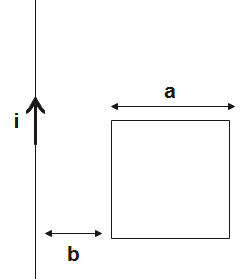Question
Question: Figure shows a fixed square frame of wire having a total resistance \(r\) placed coplanar with a lon...
Figure shows a fixed square frame of wire having a total resistance r placed coplanar with a long, straight wire. The wire carries a current i given by i=i2cos(T2πt). Find-
(a). the flux of the magnetic field through the square frame
(b). the emf induced in the frame
(c). the heat developed in the frame in the time interval 0 to 10T

Solution
As each element of the square loop is at a different distance from the current carrying wire, flux associated with each will be different. Therefore, we calculate for an element and then integrate it for the whole square. The emf generated is opposite to the direction of current but directly proportional to the rate of change of current.
Formulas Used:
B=2πRμ0I
ϕ=BAcosθ
e=−dtdϕ
Complete step-by-step solution:

Let us consider a strip of wire on the square of thickness dx. Its distance from the wire is x.
When current flows through the wire, a magnetic field is developed around it. The magnetic field intensity, B due to a long wire is given by-
B=2πRμ0I
Here, μ0 is permeability of free space
I is the current flowing through the wire
R is distance from wire
Therefore magnetic field on strip dx will be-
B=2πxμ0i - (1)
Flux associated with an area is the number of magnetic field lines associated with it.
Flux,ϕ passing through an area is given by
ϕ=BAcosθ
Here, A is the area of cross section
θ is the angle between area vector and Flux passing through dx is given by-
0∫ϕϕ=b∫b+aB(adx)⇒ϕ=b∫b+a2πxμ0i(adx)⇒ϕ=2πμ0iab∫b+ax(dx)⇒ϕ=2πμ0iabb+a[lnx]⇒ϕ=2πμ0ia[lnb+a−lnb]
∴ϕ=2πμ0ialnbb+a - (1)
Therefore, the total flux associated with the square loop is 2πμ0ia[lnbb+a].
(b). We know that emf induced in the frame is given by-
e=−dtdϕ
Substituting values from eq(1), we get,
e=−dtd(2πμ0ia[lnbb+a])
Given, i=i2cos(T2πt) therefore,
e=−dtd2πμ0ai2cos(T2πt)[lnbb+a]⇒e=−2πμ0ai2[lnbb+a]dtdcos(T2πt)⇒e=−2πμ0ai2[lnbb+a](−T2πsin(T2πt))
∴e=Tμ0ai2(sin(T2πt))[lnbb+a] - (2)
Therefore, the emf induced in the square loop is Tμ0ai2(sin(T2πt))[lnbb+a]V
(c). the formula for heat is
H=RV2dt
Here, V is the potential drop in the square loop
R is the resistance
Substituting from eq (2), we get,
H=re2dt⇒H=r1Tμ0ai2(sin(T2πt))[lnbb+a]dt⇒H=rT2μ02a2i22ln2[bb+a](sin(T2πt))2dt⇒H=rT2μ02a2i22ln2[bb+a](sin2(T2πt))dt⇒H=rT3μ02a2i224πln2[bb+a](sin(T2πt)cos(T2πt))
∴H=rT3μ02a2i224πln2[bb+a](sin(T2πt)cos(T2πt)) - (3)
Therefore, the heat developed in the square loop is rT3μ02a2i224πln2[bb+a](sin(T2πt)cos(T2πt))
Therefore by eq(1), eq (2) and eq (3) the flux associated with the square loop is:-
ϕ=2πμ0ialnbb+a.
Emf developed across its ends is:-
e=Tμ0ai2(sin(T2πt))[lnbb+a].
And heat generated is:-
rT3μ02a2i224πln2[bb+a](sin(T2πt)cos(T2πt)).
Note:
The direction of magnetic field due to current carrying wire is given by right hand thumb rule. If an area vector of a surface is perpendicular to the direction of magnetic field, there is no flux passing through it. Most of the energy of the square loop developed due to a potential difference at its ends is dissipated as heat.
